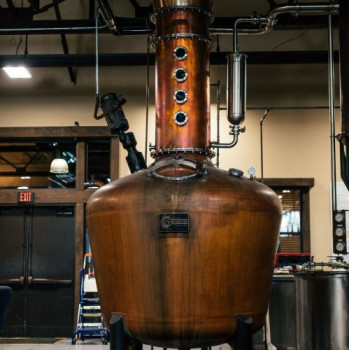How copper is used in distillation


Copper possesses not only a majestic and gleaming appearance, but also a multitude of advantages beneath the surface. Copper’s extreme malleability allows for it to be shaped into various forms, which is particularly advantageous for creating pot stills. Additionally, hammering copper strengthens it, although too much hammering can render it brittle and prone to cracking, necessitating the process of annealing. During annealing, the copper is heated with a torch until it turns cherry red, at which point it is allowed to cool before hammering can continue. Copper's ability to heat and cool quickly makes it an excellent conductor of heat, which is essential for distilling, where temperature control is crucial. The precise manner in which copper interacts with vapors during distillation is not yet fully understood, but there are two significant outcomes.
Firstly, copper "traps" sulfur compounds from the vapors, holding them within a "grid" on its surface. This reduces the levels of sulfur compounds and reveals lighter notes, such as sweetness, in the resulting spirit. Secondly, copper reacts with the acids present in the vapors, resulting in additional esters, which impart fruity notes to the spirit.
Copper is utilized in various forms throughout a distillery, from entirely copper pot stills to continuous stills with stainless-steel shells and either copper plates or fragments in baskets. Copper is also utilized in the lyne arm, which connects the pot still to the condenser, as well as in the condensers themselves.
Coppersmiths specialize in crafting essential distilling equipment such as pot stills, lyre arms, and condensers. Their work also involves monitoring equipment in distilleries for potential repairs and replacements during the maintenance season. The thickness of copper in the pot stills is regularly checked to prevent erosion caused by distillation. Traditionally, the thickness was determined by tapping the pot with a hammer, but now, a small device resembling a telephone is used to send ultrasonic signals for measurement. The typical thickness for pot stills is 5-6mm for the shoulders and 4-5mm for the neck. When the thickness reaches 1.5mm, replacement is scheduled during the silent season. A still usually requires repairs every 8-12 years, depending on the type of still.
Specialized companies such as Forsyths and Diageo's in-house division, Abercrombie Coppersmiths, have their own teams of coppersmiths. The qualification process for becoming a coppersmith in the UK involves a four-year apprenticeship, followed by a one-year engineering course and an HNC in engineering on day release over three years. It takes an additional five to six years of experience to be considered a fully qualified coppersmith.

Source: The Whisky Dictionary: an A-Z of Whisky, from history & heritage to-distilling & drinking



